
AVMA 2017: Adding a Younger Pet to a Geriatric Pet Household
Veterinary behavior expert Dr. Marsha Reich offers insight veterinarians can share with their clients who are considering adding a puppy or kitten to a home with a senior pet.
Pet owners often think that a good time to acquire a new puppy or kitten is when their current dog or cat reaches its senior years. They may hope the younger animal will revitalize the older one, or they may be looking ahead to when the older animal will no longer be around.
At the 2017 American Veterinary Medical Association Convention in Indianapolis, Indiana, Marsha Reich, DVM, DACVB, spoke about potential problems that may occur when adding a younger pet to a geriatric pet household. “Owners often assume a senior pet will instinctively get along with a puppy or kitten,” she said. “Sometimes it works, but more often it doesn’t.”
Senior pets often take steps to avoid the younger animal, but their behaviors tend to be passive and subtle, going unnoticed by most pet owners. For instance, an older dog may avoid going into a room if the younger dog is there. The older dog may avoid eye contact with the younger dog, especially it he has mobility issues.
If the younger animal doesn’t take the hint, the older dog may engage in more active behaviors to discourage the young whippersnapper. These can include lip lifting (the Elvis look), snarling, growling, snapping, or biting. Owners often view this as the older dog “putting the younger dog in its place” and think it’s acceptable or normal. In these cases, Dr. Reich recommends asking the client to provide video of how the dogs normally interact.
“What people like to tell me about are the big situations, like one pet biting another,” she says. “I want to know the subtle things so I can understand the development of a problem.”
Aging cats disengage in similar ways. Active behaviors they use to avoid interaction include hissing, growling, swatting, or chasing the younger cat.
Owners who see senior pets making an effort to avoid the younger animal should intervene by giving the young animal something to do, such as taking him for a walk or playing with him so that he leaves the older pet alone. It may be necessary to physically separate pets at certain times, especially overnight or if the pets are left alone.
Sometimes young dogs give seniors a wide berth and avoid interactions. If the younger dog is anxious and the older dog snarls at him, the younger dog may learn that other dogs can be scary, which may carry over into his interactions with all other dogs, and this can be a real problem.
In other cases, Dr. Reich said, younger dogs without good canine social skills try too hard to interact with senior dogs, resulting in more corrections from the older animal. “The more the younger animal tries to play or interact, the more aggressively the senior may react in his attempts to get the younger dog to leave him alone,” she said. The upshot can be that the younger dog eventually defends himself aggressively from the senior dog, possibly injuring the older dog in the process.
It’s not always easy to identify why pets are having a problem with each other. Address possible pain issues to improve the relationship, Dr. Reich suggested. And remind owners that when they bring a young animal into a home with an older pet it’s easier to deal with pet relationship issues early in the process, while they’re still grumbling at each other, rather than when one is injuring the other.
Newsletter
From exam room tips to practice management insights, get trusted veterinary news delivered straight to your inbox—subscribe to dvm360.




